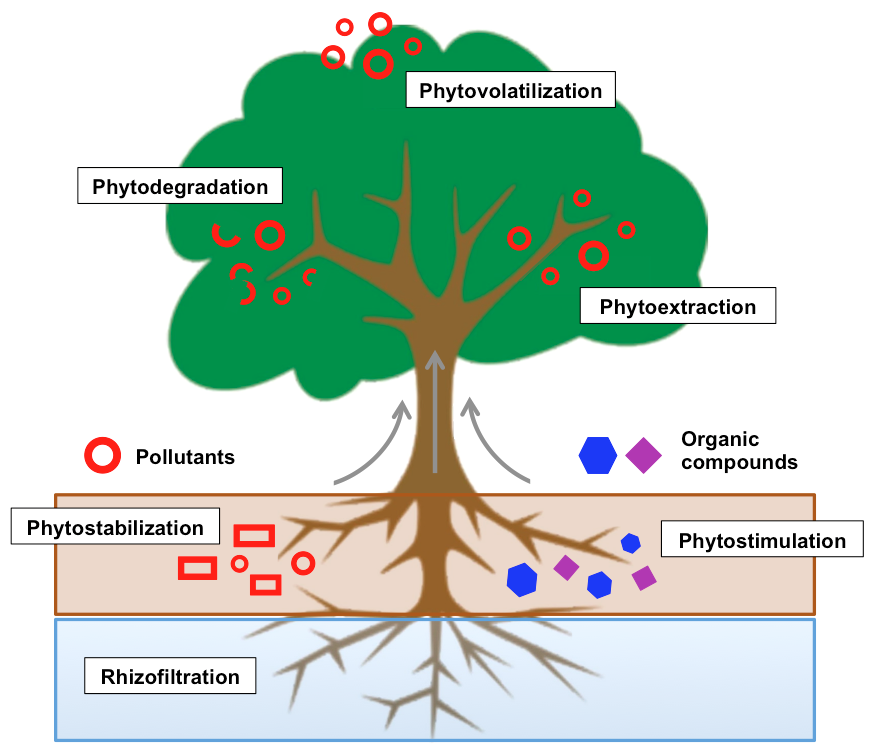Phytoremediation (‘phyto’ means plant) is a generic term for the group of technologies that use plants for remediating soils, sludges, sediments and water contaminated with organic and inorganic contaminants. Phytoremediation can be defined as “the efficient use of plants to remove, detoxify or immobilise environmental contaminants in a growth matrix (soil, water or sediments) through the natural biological, chemical or physical activities and processes of the plants”. Plants are unique organisms equipped with remarkable metabolic and absorption capabilities, as well as transport systems that can take up nutrients or contaminants selectively from the growth matrix, soil or water. Phytoremediation involves growing plants in a contaminated matrix, for a required growth period, to remove contaminants from the matrix, or facilitate immobilisation (binding/containment) or degradation (detoxification) of the pollutants. The plants can be subsequently harvested, processed and disposed.
Plants have evolved a great diversity of genetic adaptations to handle the accumulated pollutants that occur in the environment. Growing and, in some cases, harvesting plants on a contaminated site as a remediation method is a passive technique that can be used to clean up sites with shallow, low to moderate levels of contamination. Phytoremediation can be used to clean up metals, pesticides, solvents, explosives, crude oil, polyaromatic hydrocarbons, and landfill leachates. It can also be used for river basin management through the hydraulic control of contaminants. Phytoremediation has been studied extensively in research and small-scale demonstrations, but full-scale applications are currently limited to a small number of projects. Further research and development will lead to wider acceptance and use of phytoremediation.
How Does Phytoremediation Work?
There are several ways in which plants are used to clean up, or remediate, contaminated sites. To remove pollutants from soil, sediment and/or water, plants can break down, or degrade, organic pollutants or contain and stabilise metal contaminants by acting as filters or traps.
The uptake of contaminants in plants occurs primarily through the root system, in which the principal mechanisms for preventing contaminant toxicity are found. The root system provides an enormous surface area that absorbs and accumulates the water and nutrients essential for growth, as well as other non-essential contaminants. Researchers are finding that the use of trees (rather than smaller plants) is effective in treating deeper contamination because tree roots penetrate more deeply into the ground. In addition, deep-lying contaminated ground water can be treated by pumping the water out of the ground and using plants to treat the contamination.
Plant roots also cause changes at the soil-root interface as they release inorganic and organic compounds (root exudates) in the rhizosphere. These root exudates affect the number and activity of the microorganisms, the aggregation and stability of the soil particles around the root, and the availability of the contaminants. Root exudates, by themselves can increase (mobilise) or decrease (immobilise) directly or indirectly the availability of the contaminants in the root zone (rhizosphere) of the plant through changes in soil characteristics, release of organic substances, changes in chemical composition, and/or increase in plant-assisted microbial activity.
Phytoremediation is an alternative or complimentary technology that can be used along with or, in some cases in place of mechanical conventional clean-up technologies that often require high capital inputs and are labour and energy intensive. Phytoremediation is an in situ remediation technology that utilises the inherent abilities of living plants. It is also an ecologically friendly, solar-energy driven clean-up technology, based on the concept of using nature to cleanse nature.























